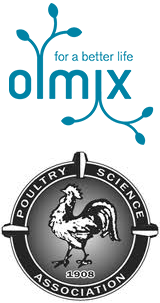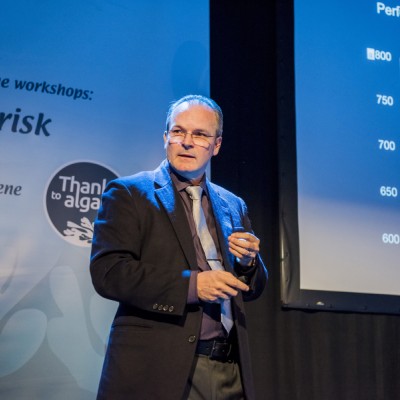
SIMPOSIO OLMIX
2019 PSA Annual Meeting
18-07-2016 Montreal, Quebec | Canadá
Un simposio de Olmix Group en el programa oficial de la PSA Annual Meeting
Descargue el programa oficial (pdf)>>
Recuerde registrarse para el simposio en el sitio web de la PSA Annual Meeting>>
Gestión del riesgo de micotoxinas y de la salud intestinal en avicultura
Importancia en la producción avícola moderna y soluciones innovadoras para su apoyo

Moderadora
Sra. Danièle Marzin
Directora de Marketing de Olmix Group
Este simposio evaluará la importancia del sistema inmunológico y la salud intestinal en la producción avícola e informará a la comunidad avícola sobre el riesgo de las micotoxinas y sus efectos en la salud e inmunidad intestinal. Se examinarán las últimas tecnologías de diagnóstico disponibles para evaluar la exposición de los animales a las micotoxinas, los marcadores de la salud intestinal, el concepto de nivel de riesgo y, a continuación, se revisarán los sistemas de prevención y los métodos de modulación del sistema inmunitario, apoyando la productividad a través de un seguimiento adecuado del estado inmunitario y de suplementos naturales innovadores en los alimentos.18
Jul
Desarrollo del sistema inmunitario en producción avícola
8:00 - 8:40
Prof. Dr. med. vet. Bernd Kaspers
Profesor de Fisiología Animal - Universidad de Munich (Alemania)
El sistema inmunológico aviar presenta algunas características únicas que están determinadas genéticamente. Las condiciones ambientales posteriores a la eclosión y la colonización bacteriana del intestino desempeñan un papel importante en la maduración del sistema inmunológico, mientras que el papel de los factores nutricionales sigue siendo poco conocido.
Coste del deterioro de la inmunidad y sus consecuencias prácticas
8:40 - 9:20
Prof. dr. Filip Van Immerseel
Investigador de la Universidad de Gante
Hoy en día, la clasificación de los órganos importantes está cambiando, adquiriendo el intestino un papel crucial, en parte debido a su implicación en las funciones inmunitarias. Para lograr un buen desempeño, es necesario evaluar tanto el coste de una respuesta inmunológica alterada como el coste de la activación del sistema inmunológico.
Toxicidad por micotoxinas: noción de nivel de riesgo e interacción entre las fusariotoxinas a nivel intestinal.
9:20 - 10:00
Dra. Isabelle Oswald
INRA - Unidad TOXALIM, Francia
Entre las micotoxinas, la fumonisina B1 y el deoxinivalenol tienen un impacto significativo en el rendimiento técnico. Estas micotoxinas no sólo son localmente tóxicas para el intestino, sino que interrumpen muchas funciones intestinales e interfieren con la respuesta inmunitaria local. Esto resulta en toxicidad sistémica que conlleva muchos síntomas. La contaminación de los alimentos con micotoxinas también altera la función de barrera del intestino, provocando la translocación de bacterias en el intestino y, por lo tanto, infecciones intestinales y sistémicas.Descanso

Gestionar las micotoxinas a la velocidad de la luz: Aplicación de la tecnología NIR al análisis de micotoxinas
10:30 - 11:10
Prof. Carlos Mallmann
Laboratorio de Análisis Micotoxicológicos (LAMIC, Brasil)
El análisis de micotoxinas es una herramienta esencial en el manejo del riesgo de micotoxinas en la alimentación animal. El control de la materia prima debe ser preciso y rápido para ser una herramienta eficaz de toma de decisiones. Recientemente, se ha desarrollado la tecnología rápida, sencilla y económica para la detección de micotoxinas mediante espectroscopia de infrarrojo cercano (NIR), que representa una alternativa muy prometedora para el sector de la alimentación animal.
Revisión de las estrategias para la desintoxicación de micotoxinas en la alimentación animal en Europa
11:10 - 11:40
Sra. María Ángeles Rodríguez
Jefe de Producto Olmix For Feed
Una estrategia para reducir la exposición de los animales a las micotoxinas es reducir la biodisponibilidad de las micotoxinas mediante la incorporación de diversos agentes de desintoxicación de micotoxinas en los alimentos. Dada la abundancia de agentes de desintoxicación disponibles, se necesitan métodos de detección para evaluar su efectividad y seleccionar los materiales apropiados. Existe una gran variabilidad en los resultados dependiendo del método y de la micotoxina utilizada.
Mesa redonda
11:40
También en el programa…
Presentaciones orales de Olmix en otras sesiones de la Reunión Anual de la PSA 2019
16
Jul
Polisacáridos de algas para mejorar la salud intestinal
Sesión: 5-Minute Abstract Presentations
14:55 - 15:00
Sra. Danièle Marzin
Directora de Marketing de Olmix Group
RESUMEN
María García1, María Angeles Rodríguez1, Mustapha Berri2, Christel Rousseaux3 and Pi Nyvall-Collen1
1Olmix Group, Bréhan, France; 2INRA, Nouzilly, France; 3Intestinal Biotech Development, Lille, France
The cell wall of marine algae is mainly composed of water soluble sulfated polysaccharides with several biological activities such as modulation of the immune response and reinforcement of gut barrier function. The present study aimed at assessing the ability of different seaweed extracts on improving gut health. The first part of the word tested a specific extract from green algal Ulva sp to upregulate the expression of immune mediators and the molecular mechanisms underlying this immunomodulatory activity by identifying the cell receptor and the signaling pathways involved. The second part of the work focussed on the the potential enhancement properties of a red algal extract from Solieria Chordalis on intestinal integrity using in vitro cell models HT-29 MTX and Caco-2 cells, under physiological and inflammatory conditions. Results showed that Ulva sp extract has the capacity to upregulate the expression of immune mediators: TNFα, CCL20, IL-1α, TGF-β that are involved in cell differentiation and proliferation, recruitment of immune cells and anti-inflammatory activities. Ulva sp extract interacts with TLR4 and TLR2 and leads to rapid activation of transcription factors PI3K and NF-κB. The red algal extract was shown to upregulate the expression of different target genes related to claudin-2, ZO-1 and ZO-2. The red algal extract upregulates the expression of mucin targeted genes: MUC4, MUC2, MUC5B and MUC5AC. The combination of both algal extracts can reinforce gut health targeting barrier function which is the first line of mucosal defense and via modulation of local innate and adaptive immune responses and induction of anti-inflammatory activities. The use of macroalgal sulfated polysaccharides can play an important role within the reduction of antibiotics in farms.
18
Jul
Efecto de un complejo algas-arcilla sobre la actividad de las enzimas digestivas y el rendimiento de los pollos de engorde alimentados con una dieta basada en maíz y soja.
Sesión: Metabolism and Nutrition: Feed Additives IV
13:00 - 13:15
Sra. María Ángeles Rodríguez
Jefe de Producto Olmix For Feed
RESUMEN
Marie Gallissot1, Rodrigo Jacob2, Luiz Fernando Albino2, Horacio Rostagno2, Raquel Pereira1, Mariel Tavares1, Maria Angeles Rodriguez1
1Olmix, Bréhan, France; 2Department of Animal Science, University of Viçosa, Viçosa, Minas Gerais, Brazil
Improving feed digestibility is a multi-faceted issue in animal nutrition. It contributes to improve livestock farming sustainability, by optimizing the use of available resources and by reducing environmental emissions, while increasing farming profitability. This study was set up to evaluate the effect of supplementing an algae-clay complex (ACC) on digestive enzyme activity and growth performance of broiler chickens fed with a corn-soy diet. The experiment was conducted at the Federal University of Viçosa (Brazil). Six hundred and sixty 1-day-old Cobb 500 male chicks were randomly distributed to 3 treatments with 10 replicates per treatment and 22 chicks per experimental unit, allocated to 1 of 3 groups receiving different diets: the standard diet (C) based on corn and soybean meal, the test diet 1 (T1), being the standard diet supplemented with 0.1% of ACC, and the test diet 2 (T2), being the standard diet supplemented with 0.2% of ACC. Animal’s performance was evaluated by measuring weight gain, feed consumption and feed conversion ratio for each feeding phase. Moreover, duodenum samples were collected at 35 days, two hours after the last feeding, from 3 chickens per replicate (30 chickens/treatment) to perform digestive enzyme activity assays. The activity of amylase (using starch) and chymotrypsin (using BTEE substrate) were measured by spectrophotometer in kinetic assay. Results showed a tendency to increase weight gain for groups T1 and T2 compared to control, though it was not statistically significant Feed conversion ratio was decreased in both test groups compared to control during the grower period (-4% and -5% respectively, P=0.043) and the whole period (-3%, P=0.038). These results were comforted by an increased activity of amylase (+25%, P<0.01) and chymotrypsin (+13 to 20%, P<0.001) in the duodenum in T1 and T2 groups compared to the control group, reflecting an improved capacity of digestion of the diet by birds supplemented with the algae-clay complex. No dose effect of the ACC product was observed. In the end, this study shows a positive effect of the algae-clay complex on feed efficiency of broiler chickens fed a corn-soy based diet. Its use at 0.1% of the feed seems the most interesting to improve performance and profitability.

